#advertising companies in cincinnati
Photo
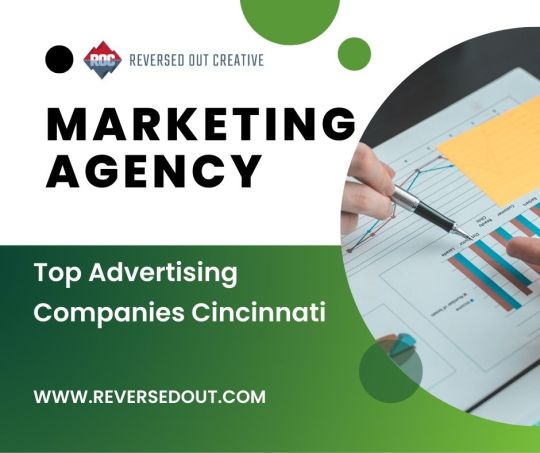
Top Advertising Companies Cincinnati
Are you looking for the top Advertising Companies in Cincinnati? If Yes then Reversed Out is one of the top-notch marketing company.
0 notes
Text
Overwhelmed By Advertising? The Battle For Cincinnati Consumers Has Raged For More Than A Century
Depending on the source, it is estimated that each American is confronted by 6,000 to 10,000 advertising messages every single day. That immersive media onslaught swelled as we started carrying little video screens around wherever we go, but invasive and obnoxious marketing has bothered Cincinnatians for much more than a century.
For example, on 20 July 1871, a correspondent for the Cincinnati Times related an enjoyable voyage he had undertaken down the Ohio River. After praising the service of his riverboat’s staff, the remarkable scenery along the river, the picturesque little town he floated by, the writer registered one complaint, about a cliff near the town of Hanging Rock:
“High up on the face of this wall of white sandstone, hundreds of feet beyond the reach of a scaling ladder, I noticed a patent medicine advertisement. It was penciled there by a man let down with ropes from above, and the letters are large enough to be read from the deck of a steamer two miles distant. I was sorry to see this defacement. It is bad enough that all the fences throughout the land should be made to lie for patent medicines without debasing the hill-sides with such marking. I suppose that when the ‘chemical affinity necessary to be the motor of some immense flying machine’ shall be discovered, some enterprising patent medicine man will be plastering the face of the moon with some of his ‘wonderful remedies.’”
If only the poor man knew what lay ahead! Even in the 1870s, almost every vertical surface in Cincinnati was slathered with posters, placards and bills advertising shows at the local theaters, patent medicines and political candidates. Cincinnati was the center of the bill-posting world. For one thing, Cincinnati was among the top printing cities of the United States, with the mighty Strobridge Lithographing Company dominating the poster industry.
Also, Billboard magazine was headquartered here in Cincinnati. What we now think of as a music magazine, Billboard was founded in Cincinnati as a trade publication for men who posted “bills” on walls. From its first issue in 1894, Billboard covered the entertainment industry, such as circuses, fairs and burlesque shows, and also created a mail service for travelling entertainers. Initially it covered the advertising and bill-posting trade and was known as Billboard Advertising.
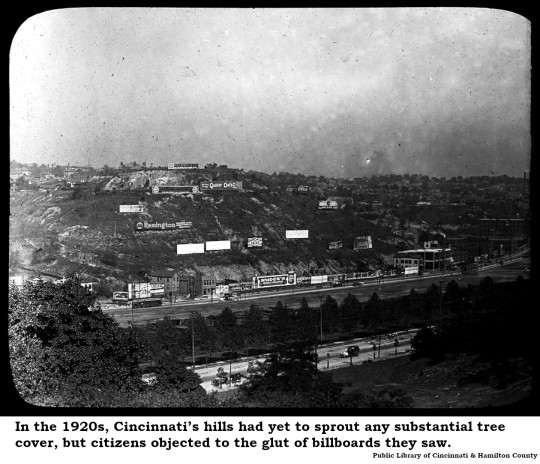
Far from inspiring civic pride, advertising rankled Cincinnati residents as they witnessed visual pollution encrusting the region’s hillsides. Leading the opposition was the Municipal Art Society – a sort of ad-hoc predecessor to today’s Urban Design Review Board. The opening shot was fired 24 August 1896 when the Enquirer reported:
“A matter that will undoubtedly be of interest to the business men is the fact that war has been declared by the Cincinnati Municipal Art Society against advertising signs on fences along the car routes and drives of the city. The art society maintains that these signs mar the beauty of the city, especially in the case of landscape scenes on the hills and in the suburbs, and that they are offensive to the public taste.”
The Society was persistent. It took five years but the Cincinnati Post reported [24 November 1901] that the Baldwin Piano Company had demolished 200 feet of billboards erected on company property along Gilbert Avenue. The Post described this as the “first result” of the Society’s campaign.
The Municipal Art Society was soon joined by some strange bedfellows. The Cincinnati Business Men’s Club, among whose members were certainly a number of advertisers who employed billboards to disseminate their messages, created its own Municipal Art Committee to lobby for restrictions on outdoor advertising. On 1 June 1907, the committee circulated a postcard illustrated with a photo of signage clogging the view from the Grand Central Depot, with the sarcastic caption, “A Nice Welcome To Cincinnati.”
As early as 1895, the city chased the Fountain saloon’s advertising off Fountain Square, but appears not to have drafted a comprehensive law about outdoor advertising until 1909 when, as part of a broader safety ordinance, the city adopted limitations on the size of billboards, their placement near thoroughfares and the materials to be used in their construction.
While the city pondered how to encourage commerce while maintaining attractive views, the entire billboard industry was gaining momentum through a Cincinnati entrepreneur named Philip Morton. Before Morton, “bill boards” were basically fences on which bill posters slapped printed advertisements glued up with a flour-water paste. Morton took outdoor advertising to a new level, according to Jay Gilbert, who has researched his influence on marketing [Cincinnati Magazine September 2016]:
“By 1898 he’d become the Steve Jobs of roadside blight. Doing business as Ph. Morton, Phil was an early pioneer of putting ads into free-standing frames called ‘bill-boards’ and plunking them down everywhere. Eventually every railroad route and motorway in America had its view ruined by a Ph. Morton billboard.”
Even the powerhouse Morton found himself in the city’s crosshairs. Parks Superintendent John W. Rodgers, according to the Enquirer [20 September 1907], exasperated by Morton’s billboards blocking the view of Inwood Park, erupted.
“Park Superintendent Rodgers yesterday tore down over 12,000 feet of big billboards that stretched along for a distance south of Hollister street, facing Vine street, in front of Inwood Park. The billboards were 12 feet high, about 1,000 feet long and contained the advertisements of leading firms of the city, and were illuminated at night with electric lights. They had been at that place for years.”
All of those billboards were leased by Philip Morton who, as coincidence would have it, dropped off a check to pay the lease while workmen were busily engaged demolishing his thousand feet of signage. This was the Boss Cox era in Cincinnati where the right hand was very often ignorant of the left hand’s activity. And so it was, while the Park Superintendent was demolishing billboards on Vine Street, the Board of Public Service pondered a lease for billboards along Gilbert Avenue. That’s right – the same Gilbert Avenue divested of billboards just six years earlier.
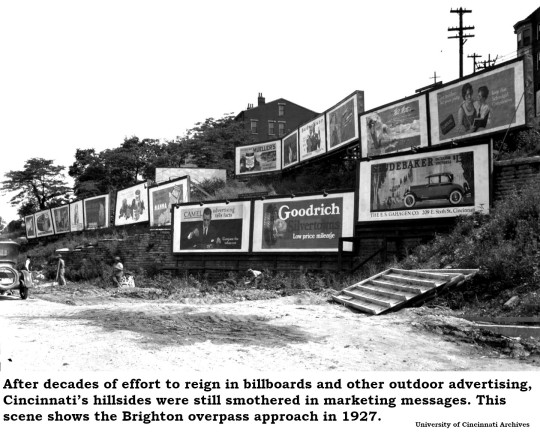
A common theme of cartoon artists at that time was the eventual coverage of all available exterior surfaces with advertising signs and slogans. In response, Cincinnati Post cartoonist Elmer Andrews Bushnell sketched City Hall wrapped from sidewalk to parapet in advertising while George Barnsdale Cox and his minion, August “Garry” Herrmann, happily apply more posters and Mayor Julius Fleischmann hides behind a billboard.
The battle raged for decades. Photographs from 1927 show dozens of billboards crowding the hillside over the Brighton overpass to Central Parkway and the Enquirer [24 March 1929] begged for relief because billboards and other unsightly structures had a negative effect on property values:
“What of the gaudy billboard that intrudes itself into a residential district, the sign which girds the tree or telephone pole, the roadside ‘shack’ which is made more ugly with bizarre advertisements? Do they affect values?”
A century later, we hardly notice billboards anymore. We’re too busy texting while we drive.

10 notes
·
View notes
Text

The Ink Beast Parade
(1903 – 1908)

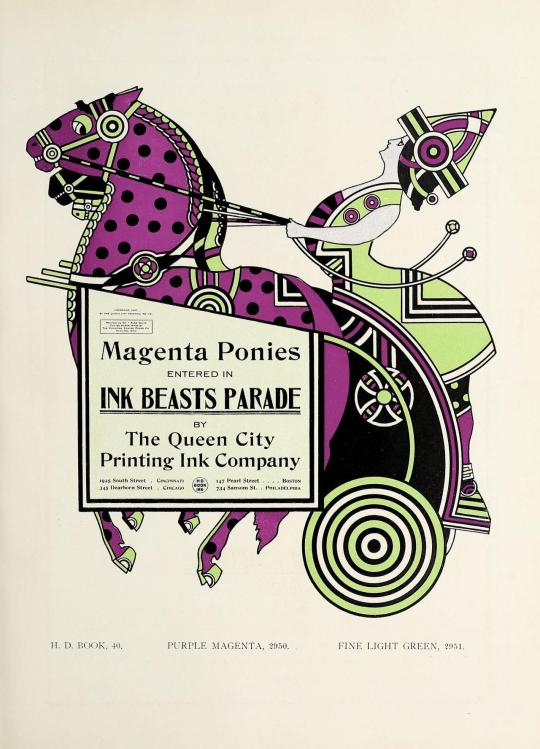
The Queen City Printing Ink Company, of Cincinnati hired Augustus Jansson to create adverts which would run in The Inland Printer trade press. The adverts aimed at ink-buyers ran from c. 1903 to 1908. Dubbed ‘Inkydinks’ by the The American Printer/The International Printer in April 1906, the bright array of ‘Ink Beasts’ were the apogee of good advertising.

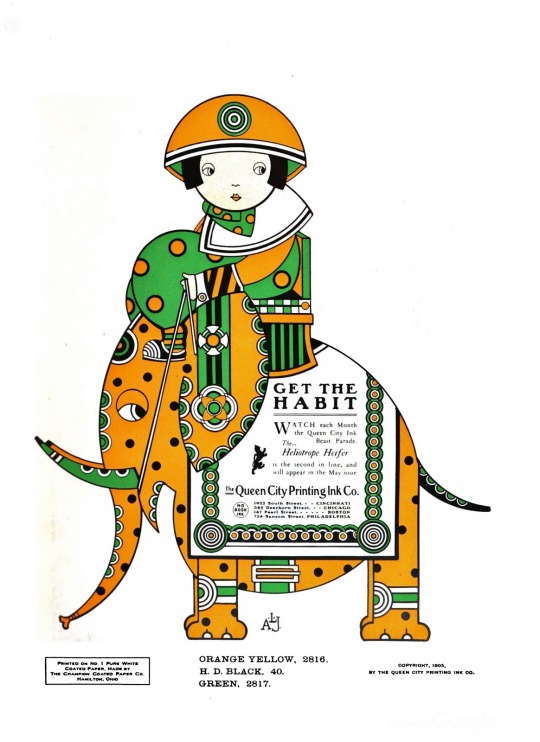


via Flashbak
#1903#1908#Queen City#Only Heliotrope Cow in the World#vintage advertising#vintage illustration#animal art#buffalo#bison#tiger#ink#Augustus Jansson#cincinnati#inkydinks
23 notes
·
View notes
Text

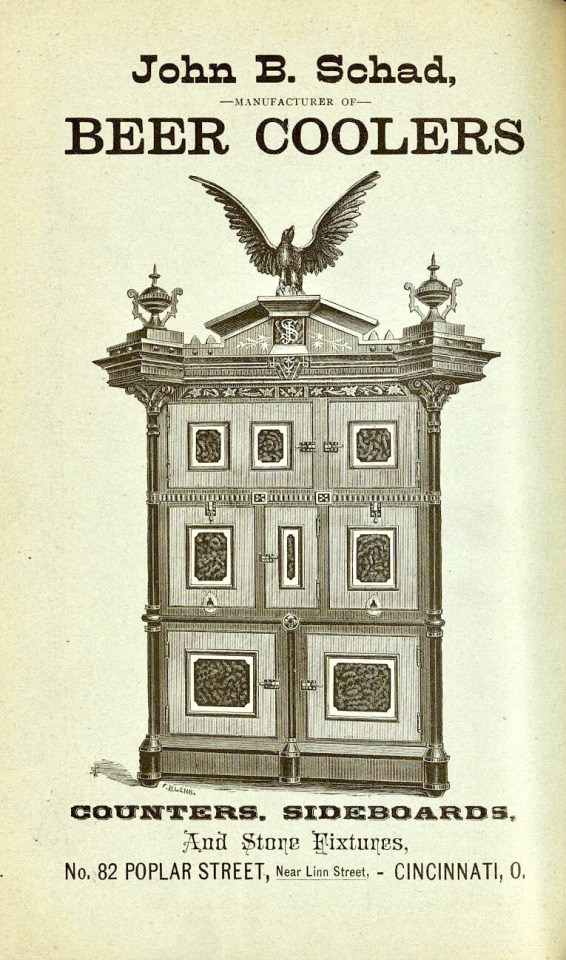
Cincinnati beer cooler company advertisments, 1886
2 notes
·
View notes
Text
Mark Singer: The Pioneering Visionary Behind The Gorilla Glue Company
Glues, Adhesives, and Sealants are substances used to hold and attach surfaces. They can be used for Craft, DIY, Repairs, Construction, and other industrial purposes and needs. Whatever you need to fix, build, stick, create, bond, and seal – these sticky glues, adhesives, and sealants are the solution. These gummy and goey stuff are made of Silicones, Silane-Modified Polymers, Polyurethanes, Methacrylates, Cyanoacrylates, Epoxies, Butyl Rubber, or Elastomers.

Incredibly stronger glues, adhesives, and sealants are used mostly in the manufacturing innovation and industrial sectors as they can be very harmful during simple craft and repair work. Having the substance of higher strength fall on any bare bodily part can prove to be detrimental and needs to be addressed immediately. The versatility of these tacky and viscous substances is more sustainable in the amount of materials used to just get the job done. Different types and kinds of materials can be bonded and sealed by glues, adhesives, and sealants without the use of extra materials for additional support. Many companies, brands labels, and organizations make their patented sticky composite and market them, which would rake in huge profits if their quality is good and gets the job done as advertised.
Therefore in this article, we will be talking about one such company founded by Mark Singer in the manufacturing industry. An American woodworker found a type of glue that was Danish manufactured, being used in Indonesia. After asking the manufacturer for the glue to modify its composition a little, Mark bought and acquired the Northern American rights for the same. He went back to his country and built The Gorilla Glue Company in 1994, whose mission is – “to make products that deliver impressive results”.
About Mark Singer – Founder of The Gorilla Glue Company:
The pioneering and trailblazing visionary who founded The Gorilla Glue Company is Mark Singer. A woodworker who has been working with wood and its related tools and types of equipment is all too familiar with how the adhesive technology of glues, adhesives, and sealants work. Woodworking, designing, and making furniture was a tedious activity for Mark. He says – “Practice, patience, proper tools, good lighting, reading glasses, and technique are all really helpful.”
Between the late 1989s and early 1990s, Mark Singer traveled from America to Bandung, Indonesia to visit a furniture factory there. He found that the workers used a type of glue unknown to Mark, on Teak furniture. The glue was made in Germany, specifically Danish manufactured. Seeing how the market was rising and how in-demand the glue was with customers, Mark went back to his country with sample bottles of the same.
“Strong enough for the toughest jobs on planet Earth” – Tagline of The Gorilla Glue Company.
On arriving back home, he tested the glue on the furniture at his workshop. He found that this glue worked on not only Teak wood but also on metals, ceramics, plastics, stones, and much more. He immediately envisioned a product that is of high quality and a brand that people would love and find to be incredibly helpful. Therefore, he approached the Danish manufacturer of the glue and asked to modify its composition a little. After this, he bought and acquired the Northern American rights for the same and brought it to America. Here, Mark started his brand building and chose the brand logo, name, and products in 1994 and launched the business that same year.
About The Gorilla Glue Company:
The Gorilla Glue Company was founded by Mark Singer, in the year 1994. It is a manufacturing company that makes waterproof glues, adhesives, and sealants for a variety of purposes in a factory established in Cincinnati, Ohio, USA. Currently, the business is family-operated by the Ragland Family. Mark Singer sold The Gorilla Glue Company to the family in the year 1999 – after which the business growth took to the skies. Mark continued to focus on his woodworking and furniture-making career thereafter.
The company manages the patented brands of – Gorilla Glue, Gorilla Tape, O’Keeffe’s, and Lutz Tool. Later after the expansion of the company due to its immediate surge in high demand and prices, Gorilla Super Glue Impact-Tough Formula, Gorilla Construction Adhesive, Gorilla Wood Glue, and Gorilla Epoxy were the other brands created and included in the manufacturing line among many other premium products.
Vision Statement – “We believe in high-quality products and choose to only put the Gorilla logo on products that meet rigorous development standards.”
Building brands that people would love and manufacturing products that they would find to be incredibly helpful, the company believes that they do this for the people they care about – “The Gorilla Way”. The Gorilla Glue Company is an all-purpose adhesive substance used for many purposes, such as – Craftwork, DIY and Builders, Repairs and Construction, and Moving and Storage purposes.
The company is headed towards sustainability efforts with the vision to have future generations still using the brand’s products. A success story, this company is a proud member of the How2Recycle Program – a smarter labeling system that recycles for Americans and Canadians, operates in local areas, has store drop-off facilities, and compostable initiatives as well. Recognized as one of the top places to work for 13 continuous years, The Gorilla Glue Company is all set gearing up for future ventures and expanding its market with more innovative and creative, sticky products.
Visit More : https://thebusinessmagnate.com/mark-singer-the-pioneering-visionary-behind-the-gorilla-glue-company/
0 notes
Link
Check out this listing I just added to my Poshmark closet: 1998 Limited Edition Coca Cola Brand Nostalgia Playing Cards in Collectible Tin.
0 notes
Text
Some staffing agencies Cincinnati, OH offer a 12-month replacement guarantee on all full-time positions. They want to make sure they are doing their best to find the best candidate for the job. In addition to extensive advertising and branding across all media to continually attract candidates, we focus on the resumes of qualified candidates and keep them up-to-date to quickly find the talent you need. Reputable agencies maintain personal databases, so you can assess their quality.
0 notes
Text
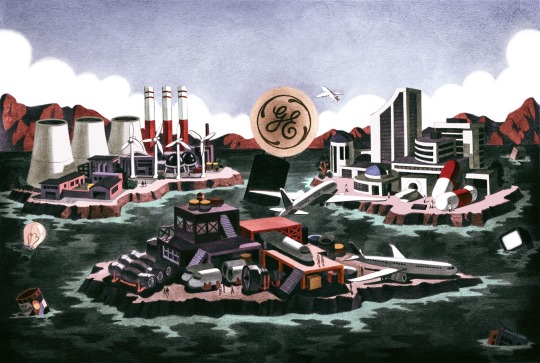
Illustration By Antoine Maillard
AN EMPIRE DIVIDED! The Inside Story of How GE CEO Larry Culp Dismantled a 131-Year-Old American Giant.
— By Brooke Sutherland and Ryan Beene | March 20, 2024 | Businessweek | The Big Take
Big sheets of white paper line the perimeter of a meeting room at the General Electric Co. factory in Beavercreek, Ohio. Each sheet is scribbled on with markers and covered with neon Post-it notes outlining the steps needed to produce the tubes and ducts that will eventually be assembled into a jet engine.
The vibe is more elementary school science fair than American industrial icon. But the simplicity is the point. Determining the layout for the Beavercreek facility was tricky: The revamped plant opened last year, combining components of production that had previously been spread out across eight different sites. To figure out the best setup, plant leaders built a replica of furnaces, tube benders and welding booths out of cardboard boxes. That visual, along with the Post-it notes describing production steps such as “brazing,” “bending” and “trimming,” makes it easier to identify and root out manufacturing inefficiencies. The exercise also helps show visiting GE executives how the whole thing works.

Featured in Bloomberg Businessweek, March 25, 2024. Photo illustration: Todd St. John for Bloomberg Businessweek
About 250 managers from around the world have gathered here in the Cincinnati area, which will be the headquarters of GE Aerospace once the conglomerate completes its slow-moving breakup in early April. One stated goal of the executive retreat is to set a culture for the soon-to-be-standalone company. “Culture can’t be declared,” says Farah Borges, who oversees GE Aerospace’s assembly, test and maintenance operations. “You have to build it.” Some declaring is still apparently necessary, because the team spent the previous day at an event space a few miles away doing just that.
But under Chief Executive Officer Larry Culp, no leadership confab is complete without a gemba walk. Gemba in Japanese means “actual place,” as in the actual place where a product is made. It’s essentially a tour of operations with a heavy emphasis on Q&A with the factory staff. The practice is central to lean manufacturing, an influential operations philosophy developed by Toyota Motor Corp. that Culp has championed at GE.

Culp at the Beavercreek factory in February. Courtesy: General Electric
Factory floor visits aren’t a radical idea for an industrial company, but GE didn’t always do them this way. The company used to place more emphasis on polishing a PowerPoint presentation than on drilling into the details of manufacturing workflows, says Russell Stokes, the head of commercial jet engines and services, who’s been at GE for more than 25 years. Somewhere between the wrong-way financial bets that blew up in the 2008 economic crisis and a huge, disastrous acquisition of energy assets from Alstom SA in 2015, GE, with its persistent mindset that anyone with an MBA could run any business, forgot that it’s a manufacturer at heart.
When Culp became CEO in 2018, GE was far too big and complicated for its own good, and the company’s businesses weren’t bringing in enough money to support its sky-high debts. “We were at risk of not making payroll, in a manner of speaking,” he says. He managed to pay down more than $100 billion of the debt through a series of well-timed divestitures. He dismantled GE Capital, its investment arm, largely untangling the company from a financial albatross. And then, in 2021, he announced that GE—the quintessential American conglomerate, which at one point or another sold washing machines, credit cards, plastic resins and TV advertising slots for NBC’s Super Bowl broadcasts—was breaking up. None of those efforts would’ve been as successful, and perhaps wouldn’t have even been possible, if Culp hadn’t tightened up GE’s operations and turned key businesses into stable, cash-generating entities that could stand on their own.
Today, GE’s stock is near a seven-year high. GE HealthCare Technologies Inc., which split off in 2023, is up about 50% from its debut. The final piece is the electric-grid, gas-power and wind-turbine business, which will become its own standalone company called GE Vernova on April 2.
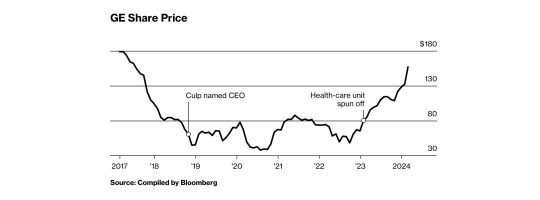
In one sense, Culp is restoring GE to its original identity as a maker of stuff. But he’s also the guy dismantling a monument to American capitalism. From its inception as an outlet for Thomas Edison to commercialize the lightbulb through the era of rapid globalization embodied by Jack Welch, GE practically swallowed entire industries. It loaned planes to companies and money to real estate developers; for a time it even owned a large chunk of Dreyer’s Grand Ice Cream. Most of that is gone now. Culp divested the aircraft leasing arm, biopharmaceutical assets and the remnants of GE’s oil and gas operations and saw through sales of its locomotive and lightbulb units. Even the GE name is on loan. GE appliances are made and sold by China’s Haier Smart Home Co. The new GE will just be a manufacturer of jet engines, essentially, with a few random money pits left over from the old conglomerate, like insurance for elder care and a Polish mortgage business. “We constantly debated what the right structure was,” says Ed Garden, a GE board member since 2017. “But the first order of business was fixing the underlying businesses.”
On the gemba walk, Culp and his aerospace deputies stop to meet with the plant’s lean manufacturing leader, Cem Salahifar, who launches into an overview of the factory’s operations. He describes the facility’s transition from a single, giant furnace—known in manufacturing parlance as a monument—to a bunch of smaller ones spread out around the factory floor. This eliminates the need for employees to shuttle components back and forth and stand around waiting for the heating process to complete. Turnaround times for this part of the production process dropped to 30 minutes from four hours. Culp interjects: The team should appreciate how meaningful this change was, he says, for improving efficiency. He then asks them to find ways to rethink the monuments in their own factories. “We like to tear down monuments,” Culp says.
General Electric Through the Years
The historic American company amassed a sprawling portfolio that at one time or another included locomotives, washing machines, insurance, lightbulbs, MRI machines, credit cards, real estate and the television network NBC.
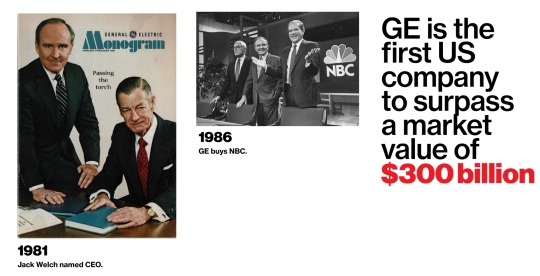
To be CEO of GE is to be compared with the late Jack Welch. For most of his two-decade reign, Welch made the company bigger, more valuable and more profitable. But the sun began to set on the age of the conglomerate by the time he retired in 2001, and soon other industrial giants were breaking up. Post-Welch CEOs at GE found themselves trying to explain why it made sense to be big for the sake of being big. Jeff Immelt, Welch’s handpicked successor, talked up the benefits of the “GE Store,” a shared repository of technological tools that the whole company could pull off the shelf. In reality, there was no good reason why one company needed to sell MRI machines, jet engines and wind turbines. Even worse, GE’s voluminous sprawl left too many places for problems to hide.


Left: A Leap engine at the Lafayette Engine Facility in Indiana. Photographer: Christopher Payne/Esto/Redux Right: A jet engine test operation. Photographer: Christopher Payne/Esto/Redux
One of the biggest problems was GE Capital, which helped fuel stock growth during the Welch years but proved to be a time bomb. GE had loaded up on debt to support its ventures in corporate lending, real estate, credit cards, mortgages and insurance. When the economic crisis arrived in 2008, GE Capital had more than $500 billion in assets and almost as much debt, which made it the largest financial company in the US that wasn’t technically a bank. As customers worldwide defaulted on loan payments and investors lost their appetite for risk, GE turned to Warren Buffett and the federal government for financial support. Immelt cut GE’s dividend for the first time since the Great Depression. He later sold off huge chunks of GE Capital, but it continued to haunt his successor, John Flannery, who in 2018 disclosed a $15 billion hole in a long-term-care insurance business Immelt had been unable to fully get rid of. The timing couldn’t have been worse: Flannery had cut the dividend two months earlier, to some shareholders’ dismay, and with the gas-power business in a slump and fewer GE Capital assets, there just wasn’t enough money from its operations to keep handing out such generous payments to investors.
GE’s stock was in free fall in 2018, and Flannery overhauled the board. One of the new directors was Culp. A graduate of and former senior lecturer at Harvard Business School, he’d previously been the CEO of Danaher Corp., a onetime industrial conglomerate in its own right that’s idolized by investors for its operational rigor. (Danaher eventually broke up, starting in 2016 with the spinoff of the industrial products company Fortive Corp., shortly after Culp left.)
Culp’s Message: “Everybody Around The Boardroom, Don’t Panic”
Flannery announced a plan to spin off GE’s health-care business in June 2018, but such a wholesale breakup quickly became untenable. The company couldn’t afford it: The remaining operations wouldn’t have generated enough cash to allow GE to pay off its mountain of debt. “We could not spin health care without putting everything fundamentally at risk,” Culp says.
GE’s directors asked Culp if he wanted to run the company. He turned them down—twice, he says—but an August 2018 visit to GE’s gas-power operations in Atlanta began to change his mind. The place was a mess, he tells Bloomberg Businessweek. “We were managing the business in a way that was probably 180 degrees from the way we ran things at Danaher,” he says. But Culp saw a path to fix GE’s operations. His message: “Everybody around the boardroom, don’t panic.”
GE directors offer a bingo card’s worth of MBA-speak to describe how rough the situation was. Tom Horton, former CEO of American Airlines, says he and Culp were both “eyes wide open” when they joined the board together in 2018: “Once we got under the hood, the challenges were more substantial than maybe we anticipated.”

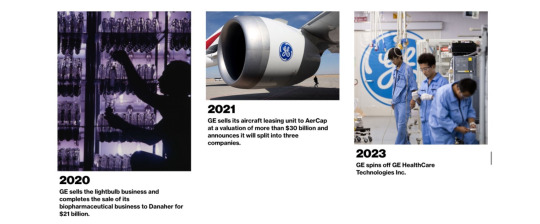
Two months after his visit to Atlanta, Culp was named CEO. In short order, he slashed the dividend to $0.01 a share and killed the plan to spin off health care. Instead, Culp brokered a deal to sell GE’s biopharmaceutical unit to his former employer Danaher. GE received $21 billion in cash for the business, which makes equipment and materials used to manufacture drugs, and offloaded $400 million in pension obligations to Danaher. The transaction was completed in March 2020, about three weeks after the onset of the Covid-19 pandemic brought air travel to a halt, creating an existential challenge for the company’s jet engine business. “I don’t know what would have happened if we hadn’t closed that deal,” Culp says.
GE directors thought the pandemic had made Culp’s job harder, and they wanted to give their CEO another reason to stick with it. In August 2020, the board altered the terms of Culp’s compensation package to give him more time to reach performance targets for a one-time stock bonus and make it meaningfully easier for him to have access to the top payout of about $230 million. Shareholders representing a majority of voting stock opposed the pay deal, but their vote was nonbinding, and the board had already approved the changes anyway. Culp accessed the top tier of the equity grant in July 2023, and the shares will vest next year unless he retires before then. (GE later curbed other aspects of Culp’s compensation.) “We were securing Larry’s leadership for a longer period of time, and that’s proven to be certainly in shareholders’ interest,” Horton says.
There are parallels between Culp and Welch, a company legend who was also legendarily well-compensated. The underlying principles of the lean manufacturing philosophy Culp preaches aren’t all that different from Welch’s cult of Six Sigma, another corporate dogma focused on measuring the rate of operational defects and eliminating inefficiencies. But the two are otherwise very different. Welch’s habit of ranking employees by performance and summarily firing the bottom 10% created a culture of mistrust. Employees who survived layoffs started to think they were the smartest people in the industry, a mentality that persisted after Welch retired and GE began to fade.
Culp has been programming a new mantra into his subordinates, adapted from his time at Danaher: We’re not perfect. “You’ll have some home runs, but you don’t need them every day,” says Jim Lico, who worked for Culp at Danaher and is now president and CEO of Fortive. “No one is perfect.” That kind of talk might’ve gotten a Welch-era executive fired, but it’s part of Culp’s belief in continuous improvement that his team routinely parrots.
This often manifests with seemingly small changes that can make a big impact on productivity over time. In one instance, GE reduced the distance a part must travel around its plant in Greenville, South Carolina, by about 3 miles, says Scott Strazik, the CEO of the soon-to-be-spun-out energy business GE Vernova. Even something as small as reorganizing the toolboxes used by turbine repair technicians can make a big difference. “There’s a long way to go,” Strazik says. GE Aerospace is trying to get its many factories to coordinate more with one another and with the teams that handle contract reviews and other back-office tasks. That process isn’t “perfect,” even if it has improved, says Kayla Ciotti, materials and planning leader at GE Aerospace. “Ten years ago, we had brick walls. Five years ago, we had screen doors,” she says. “The door is open now. There’s no door.”
In contrast with the cutthroat culture at Welch’s GE, Culp’s employees will get some leeway if they do walk into walls. “That doesn’t mean that if you screw something up and you do it repeatedly, there isn’t responsibility to bear,” Culp says. “But a problem-solving culture is far more effective operationally than a finger-pointing culture.”
Brian Carlson remembers his first gemba walk with Culp. Carlson, who runs the 1.2-million-square-foot GE factory in Schenectady, New York, that makes power plant generators, watched Culp stop at one production line in 2019 to inspect a reel of copper wire, which workers fashion into long, braided slabs bent like hockey sticks at both ends. Known as stator bars, these parts are installed inside the guts of enormous generators, which can weigh more than 400 tons. Culp was checking the manufacturing date on a reel of wire. Dozens of reels were stacked on shelves and pallets at the station, burning cash as long as they sat unused. “Others had visited Schenectady before, but it wasn’t into that level of detail,” Carlson says. “When Larry Culp shows up and wants to see how long your material’s been sitting on the factory floor, that simple gesture really sets a tone.”

The foam model at the Schenectady factory. Courtesy: General Electric
After that visit, workers cleared out a large room that once housed office space near the factory’s entrance and spent months building a scale model of the entire factory from hand-cut pieces of white and green foam, which they carefully laid out on rows of folding tables. Placards hang overhead marking each section of the factory, the largest of which declares the purpose of this enormous diorama: “Take it to the model before you take it to the floor.”
The foam factory is now a hub of Schenectady’s operations. Factory staff simulate projects first in the room before testing them on the factory floor. This is part of what’s known inside GE as a kaizen event. Culp loves a good kaizen. The Japanese term means continuous improvement and is another tenet of lean manufacturing. It’s a method for problem-solving that Culp has pushed throughout the company, in which executives and hourly workers dedicate a week to improve a production process, such as the stator bars that caught his attention during his visit in 2019. The goal is to come up with a solution by Friday and have the new process in motion on Monday.
The old way of making stator bars involved moving parts by crane through a 26-step process that took about three months to complete. Each bar now moves on rollers through an eight-step process in as little as three weeks. And now there’s only enough copper wire on hand to sustain a single shift.
On an unusually warm day in late February, Carlson motions to an area on the stator bar line where more improvement is needed. They still use a crane to hoist bars over an active walkway that crosses through the assembly line. A fix is in the works. “See,” he says, “we’re not perfect yet.”
“We Do Not Intend, Let Me Be Clear, To Be All Things To All People”
By early 2021, Culp’s turnaround of GE was starting to take hold, but the company was still sitting on too much debt. A solution arrived that March, when AerCap Holdings NV agreed to acquire GE’s aircraft leasing unit. The deal would allow GE to pay off $30 billion it had borrowed, reducing its debt to the point where the company could realistically think about establishing three separate businesses—in aerospace, health care and energy—that investors would actually want to own.
Culp started mapping out a breakup plan and gave it a code name: Project Revere, inspired by a monument to American patriot Paul Revere near Culp’s home in Boston. He liked the history motif. As GE’s board deliberated a split-up, a defining moment came in a PowerPoint presentation. A slide illustrated the degree to which investors were avoiding the stock simply because it was a conglomerate. “When you just looked at the companies that folks who really wanted to bet on the energy transition or on commercial aerospace were invested in, it was not with us,” Culp says.
In November, a week after the AerCap deal closed, GE announced the spinoff plan. “Everyone felt the weight of that decision,” Culp says at GE Aerospace’s Learning Center in Evendale, Ohio, where visitors can tour a museum of the company’s aerospace achievements, starting with the first American jet engine.
A breakup was never the only option, but it was the best one. Although modern conglomerates do exist (Alphabet, Amazon, Microsoft), GE’s ye olde smokestack model wasn’t working anymore. Investors were getting burned by its bigness more often than they were getting rewarded. The conglomerate structure is especially limiting when it comes to spending money, says David Giroux, a portfolio manager and chief investment officer of T. Rowe Price Investment Management. Massive companies tend to make the wrong acquisitions and overpay for them.
One deal Culp didn’t do was to pay an acquirer to make GE’s insurance problem go away. “There were checks back in the dark days that we could have written that would have been akin to having people tear our eyeballs out,” Culp says. “But you never want to be on the other side of that sort of trade.” Although GE hasn’t done any new business in long-term-care insurance in almost two decades, it’s still paying off claims it agreed to back for other providers. It’s now closed the $15 billion insurance funding shortfall, and investors treat the appendage as more of a quirk than the crisis it was in 2018. Culp says he might get rid of the business someday. But he’s not in any rush.
After the breakup, GE Aerospace will have $25 billion of cash to spend on dividends, share buybacks and acquisitions—with the first two taking priority. Culp won’t say what kinds of deals GE Aerospace might do, only that he’ll look for complementary and easily digestible assets. “We do not intend, let me be clear, to be all things to all people,” he told investors in early March.
All of GE’s gemba walks and kaizens and the intense scrutiny of its manufacturing operations look especially prudent after a series of high-profile quality-control failures among its peers. RTX Corp. is recalling thousands of jet engines because of a manufacturing glitch; Siemens Energy AG sought help from the German government after defects in its wind turbines resulted in massive losses; and Boeing Co. can’t even deliver its 737 Max with all the bolts properly installed.
When there are three GEs, Culp hopes the old name still means something to investors. He says that’s one reason he took the job in the first place: “It’s GE.”
At the company’s off-site in Ohio, executives gathered at Carillon Historical Park in Dayton. It’s home to the Wright Brothers’ Wright Flyer III, the first practical airplane. This piece of aviation history sits next to Culp’s Cafe, which serves an All-American egg sandwich and coffee for $13. The cafe has nothing to do with GE’s CEO. It’s named after Charlotte Gilbert Culp, who founded a baked-goods business in 1902 as a young widow in Dayton. At that time, GE was still just an electrical company.
#Bloomberg#Businessweek#The Big Take#General Electric#GE | CEO | Larry Culp#Dismantling of GE#An Empire Divided
0 notes
Text
4 Entrepreneurial Secrets Every Teacher Needs to Empower Learning
The entrepreneurial spirit isn't confined to the world of business – it can thrive in every classroom, every day. It aligns seamlessly with dynamic project-based learning and captivates students through engaging classroom projects. In this episode, we're joined by Stephen Carter, author of 'Teaching the Entrepreneurial Mindset.' Stephen delves into the four pivotal aspects of an entrepreneurial mindset that are essential for educators at all levels. He shares insights from his extensive experience as the Director of Entrepreneurship and Sustainability at Cincinnati Hills Christian Academy, where he's not only taught for 18 years but has also revolutionized their entrepreneurship program. Join us as Stephen Carter gives an approach for every educator to empower their students with entrepreneurial thinking.
Show Sponsor: Edge U Badges - Edge U Badges from Forward Edge is a fantastic micro credentialing program for teachers, administrators, and school staff. In this program, you can earn contact hours or graduate credit.
With the ISTE Seal of Alignment, this program is approved by many districts as a flexible, personalized way for teachers to learn and grow. They will work with you to help your district accept your transcript for licensure renewal hours.
Edge U Badges has former teachers review every single badge within 1-3 business days of submission, and no badge is ever denied without very specific feedback on what you can do to resubmit successfully or positive feedback on successful submissions.
This is a program that I'm reviewing for my own renewal that comes up this year and I'm excited about their micro-credentialing system, which is why I'm recommending it to you!
Use the code COOLCAT for $20 off a premium account.
Disclosure of Material Connection: This is a “sponsored podcast episode.” The company who sponsored it compensated me via cash payment, gift, or something else of value to include a reference to their product. Regardless, I only recommend products or services I believe will be good for my readers and are from companies I can recommend. I am disclosing this in accordance with the Federal Trade Commission’s 16 CFR, Part 255: “Guides Concerning the Use of Endorsements and Testimonials in Advertising."
New 10 Minute Teacher Podcast episode
0 notes
Text
Factoring For Staffing Businesses Scale Funding
This is why we attempt to make the funding course of for staffing company loans straightforward and accessible. We will consider your organization's wants and targets to choose a funding program that may fulfill all of your business wants. Once you've completed our short 2-page application kind online and have been permitted for a financing receivables program, we will pay you for the outstanding invoices within 24 hours. We Make Invoice Factoring A Simple Process1st Commercial Credit provides receivable factoring services for all kinds of businesses serving many industries in Kentucky. If your corporation sells providers or products to other companies, your small business will likely be eligible for our accounts receivable financing program. 1st Commercial Credit is a specialised lending company offering financing solutions to startups and small companies in Kentucky.
Government contracts present regular, dependable, and worthwhile work to contractors. Working with the federal government is doubtlessly a huge opportunity for stable enterprise progress. As a contractor, acquiring one government contract means you possibly can easily acquire extra.
You can establish a strong reputation in your neighborhood by offering high-quality companies and asking for referrals from glad shoppers. Word-of-mouth suggestions are not only nonetheless helpful in today’s employment panorama, however they’re cheaper than other conventional advertising strategies, corresponding to advertising. Imperative for rising your client base, networking establishes you as a trusted provider of house healthcare providers and is necessary for agencies eager to get contracts with hospitals. Like short-term contracts, staffing agencies handle all of the elements of long-term contracts. They present nurses with the coaching, scheduling, and instruments they should succeed.
By working with a factor, temporary staffing companies can tap into this experience and benefit from finest practices in invoice administration and collections. This may help to enhance the general financial well being of the corporate and may even result in long-term improvements in cash circulate and profitability. Late payments and unpaid invoices can have a unfavorable impression on a company’s credit rating. This can make it troublesome to secure financing and might even lead to larger interest rates and fees. By utilizing invoice factoring, companies can enhance their cash move and ensure that invoices are paid on time, which may help to improve their credit score scores over time. This may cause issues for staffing companies because most staffing shoppers by no means pay within 30 days.
1st Commercial Credit has worked with manufacturers in Cincinnati for a quantity of years. This expertise allows us to better understand the business's challenges and supply a reliable service to our clients. With factoring, your business will have quick access to the working capital needed to cover business bills.
We are committed to working exhausting for our clients and getting them funded shortly. Riviera’s FastCredit is one of the first tools in the factoring business that provides an immediate, automated credit score approval. The low cost price, also called a factoring fee, ranges between 1%-5%, and the advance price is usually between 75% and 95%. Some factoring companies do weekly factoring charges decrease than 1%, and a few offer 100% advance charges.
invoice factoring temporary staffing companies
This possibility entails promoting outstanding invoices to a third-party firm, often known as an element, in trade for quick money. The factor will usually provide a share of the invoice value upfront, with the remainder being paid once the invoice is collected. Staffing factoring doesn’t require collateral and approval isn’t based mostly in your credit history.
Staffing factoring, also referred to as payroll factoring, is a particular form of invoice factoring tailored to staffing and temporary employment companies. Staffing companies are often caught in the dilemma of not getting paid for several weeks however having to make payroll every week or each different week. Invoice factoring is designed particularly for businesses like staffing due to the unique payment construction. In staffing, you typically have to wait days for cost out of your shoppers, whilst you pay your staff weekly. Invoice factoring offers you the money essential to develop with out having to worry about making payroll. Advance Partners supplies invoice factoring for staffing, recruitment and temp companies.
#invoice factoring temporary staffing companies#invoice factoring temporary staffing#temporary staffing invoice factoring#temp staffing invoice factoring
1 note
·
View note
Text
Mosquito Shield of Northeast Cincinnati

Mosquito Shield: The Proven Leader in Commercial & Residential Mosquito & Tick Control Services
About Mosquito Shield of Northeast Cincinnati
Hi, my name is Craig Dzubak and I’m the owner of Mosquito Shield of NE Cincinnati.
I got into this business because I wanted to allow families to make the most of their backyards. Especially in the summer, when outdoor activities are prime. I found this to be an opportunity to build and grow a business that can actually serve my community in a meaningful way.
I’ve been in the area for 7 years now. I am an outgoing and forward person. With me, what you see is what you get. There’s no tricks or gimmicks, I will do what I say I’m going to do and that’s that. However, I understand that actions speak louder than words. That’s why I guarantee once you try us, you won’t want to go without us.
I’m excited to make a difference with our superior product and customer service. We have a unique application strategy based on mosquito populations and weather patterns. When our strategy is combined with the Mosquito Proprietary Blend (MPB) that we’ve spent over 20 years perfecting, the results are far superior to any competitor.
We’re dedicated to our process and are accountable for our product and services. We stand behind our work and are proud to say you’ll get what you paid for with us, a mosquito free lifestyle with no worries of bites or buzzing.
You have my personal guarantee that you will get what is advertised. Our application strategy is rooted in mosquito science. We act and plan from several angles based on the disruption of the mosquito life cycle. This allows us to be more successful than any other provider in eliminating, repelling, and preventing mosquitoes on your property for the entire season.
We’re confident enough in our work that we offer a satisfaction guarantee. If you don’t notice a difference after our first spray within 48 hours, we’ll come respray. After 7 days, if you’re not happy with the product, we’ll give you a full refund.
Residential Mosquito Control Services for Your Yard
If you’re tired of battling annoying mosquitoes in your backyard all summer long, there is a simple and effective solution available to you. Mosquito Shield® is proud to offer the best mosquito control service on the market. As an experienced outdoor pest and mosquito control service company, we feature two effective products and services that will transform your backyard into the peaceful place you and your family have always dreamed of.

What You Can Expect With Mosquito Shield Products
With Mosquito Shield® you get the most comprehensive mosquito or tick control service available to help you enjoy everything you love about being outdoors. Learn more about how Mosquito Shield works here:
Our Money Back Guarantee.
Your first visit will be scheduled within five business days of signing up.
An email notification will be sent before and after each visit.
You will see a significant reduction after your first visit, typically within 24 hours.
A licensed technician will visit your property approximately every two weeks, depending on mosquito population and weather conditions. Treatment intervals can be as short as 10 days and as long as 17 days.
A polymer, which acts like a rain shield, is added to each spray, helps the product withstand light to moderate rain and allows the barrier to remain in effect.

What makes Mosquito Shield and Tick Shield so much better?
PROVEN: 20 YEARS OF EXPERIENCE
20 Years and over 1 million applications have helped us renew our FlexBlendTM formula that lasts longer, holds up against weather, and grows in strength as the season progresses. Plus, our techniques allow your family and pets to return to the yard quickly after service!
EFFECTIVE: A DIFFERENT APPROACH
We are the only mosquito & tick control service with the Tailored Treatment System that responds to weather-related breakouts and seasonal peaks in mosquito & tick populations - no preset number of treatments means more attention to your property!
AFFORDABLE: UNCONDITIONAL MONEY-BACK GUARANTEE
If you’re not fully satisfied after your first visit, we’ll refund 100% of your money.
✆ (513) 572-1835
#mosquito shield#mosquito control#tick shield#tick control#pest control#pest shield#environment#services#home#house#northeast cincinnati
1 note
·
View note
Text
The Role of a Marketing Consultant in Driving Business Success
In today's fiercely competitive business landscape, staying ahead requires more than just a great product or service. This is where a marketing consultant steps in, offering valuable insights and strategies to propel businesses toward success. A marketing consultant is a professional who collaborates with companies to enhance their marketing efforts and achieve their goals. Their responsibilities encompass a wide range of tasks aimed at increasing brand visibility, customer engagement, and ultimately, boosting revenue.
Responsibilities:
Marketing consultants wear various hats to achieve their objectives. They conduct thorough market research to understand the target audience and competitors, enabling them to craft effective marketing strategies. They often develop comprehensive marketing plans, which may include social media campaigns, content creation, SEO optimization, and more. Additionally, marketing consultants analyze data and key performance indicators to assess the effectiveness of their strategies, making necessary adjustments to ensure optimal results.
Strategies for Success:
Marketing consultants devise tailored strategies based on the unique needs of each business. They might recommend harnessing the power of social media marketing, as platforms like Facebook, Instagram, and LinkedIn can greatly enhance brand visibility and engagement. Content marketing is another potent tool, offering valuable information to customers and establishing the business as an industry authority. Pay-per-click (PPC) advertising can swiftly drive targeted traffic, while search engine optimization (SEO) ensures long-term online visibility. Email marketing remains a robust method for nurturing customer relationships and driving conversions.
Statistics and Costs:
Marketing consultant charges can vary widely based on factors such as experience, project scope, and industry. On average, their hourly rates range from $100 to $250, with retainer-based arrangements potentially costing $1,000 to $5,000 per month. However, the return on investment (ROI) is often significant. Many businesses experience substantial growth in terms of revenue and customer base. The Return on Advertising Spend (ROAS) is a key metric to gauge the effectiveness of marketing campaigns. A healthy ROAS is usually around 4:1, meaning for every dollar spent on advertising, the business generates four dollars in revenue.
In conclusion, a marketing consultant plays a pivotal role in guiding businesses toward success in today's competitive market. By crafting tailored strategies and leveraging various marketing channels, they enhance brand visibility, engage customers, and drive revenue growth. While the costs of hiring a consultant may vary, the potential ROI and ROAS make it a worthwhile investment for businesses looking to thrive and stay ahead in their respective industries.
This Article was written by
The Digital Hunt - Cincinnati SEO Consultant
Boost your online presence with Cincinnati SEO consultant. We offer expert services, local optimization, and effective strategies.
0 notes
Text
18 Modern Words That Had Very Different And Curious Meanings In Old Cincinnati
Some words we use daily today meant something totally different more than a century past. Here are a few normal, everyday terms that once had surprisingly altered definitions long ago in Cincinnati.
Affinity
In the early 1900s, “affinity” meant something very much like “soulmate” does today. In Cincinnati newspapers, “affinity” usually shows up in articles about divorce. Many a husband sought a divorce because he had found his “affinity”, and it wasn’t the woman he was married to. Jacob Pels told the Cincinnati Post [31 October 1907] on the occasion of his second divorce: “Twice I thought I found my affinity, and twice I made a bad mistake.”
Blue
Today, if you’re blue, you are mildly depressed. Back in Old Cincinnati, “blue” meant risqué, or even obscene. Cincinnati ministers erupted in indignation when Millie DeLeon, the “Girl In Blue” (wink, wink!) performed at Heuk’s People’s Theater on Vine Street in 1901. And, when Cincinnati Redlegs Manager Clark Griffith excoriated the team after a dismal spring training game in Georgia, the telegraph company refused to carry the Enquirer’s dispatch [14 March 1909]: “Wishing to be perfectly accurate, we wrote out the rest that Griff said, but the telegraph man would not send it. He said his wire was a family wire of good and regular habits, and he would not insult it by asking it to carry a lot of blue language.”
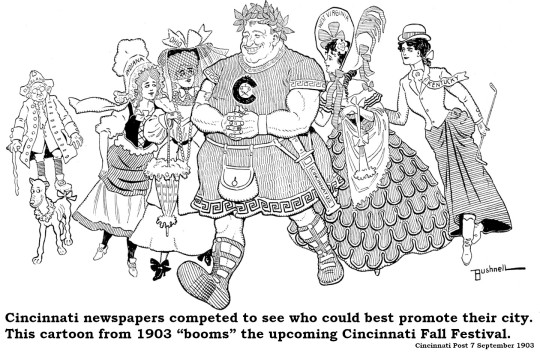
Boom
This old term had nothing to do with firecrackers or other explosions. It meant to promote, or to hype, or to publicize. When Judge Andrew J. Pruden wrote to the editor praising a Cincinnati Post editorial, the Post headlined his letter [6 January 1893]: “Judge Pruden Indorses The Post In Its Efforts to Boom The City.” An editorial an 1888 edition the old McMicken Review at the University of Cincinnati encouraged students to “Boom the ‘Varsity!” Cynical Thomas Emery, a pioneer real estate developer, told the Post [1 July 1886] he was concerned about future investments: “Boom Cincinnati? Can you boom a dead dog? I don’t mean that Cincinnati is dead exactly, but she’s overbuilt.”
Brace
To brace somebody meant to cheat them, and Cincinnati was swarming with galoots just salivating at the opportunity to brace someone. The bracers needed to watch out who they braced, though. Frank Y. Grayson in his classic “Pioneers of Night Life” tells the tale of Frank James, Jesse’s brother, getting fleeced at a Cincinnati card game: “James dropped $800 on the night. He knew that he had been braced. Before he left he said genially, ‘Well, boys, I’ll say one thing for you, you get it easier than I do.’”
Cake
We’re not talking pastry here. This word figures into one of the most obscure lines in Ernest Lawrence Thayer’s classic “Casey at the Bat” from 1888:
But Flynn preceded Casey, as did also Jimmy Blake,
And the former was a hoodoo, while the latter was a cake;
A “hoodoo” we still recognize as a jinx, but a “cake”? In 1888, everyone knew that a cake was a fool. Within the context of baseball, a cake was a loser.
Candlelight
Many a romantic evening has been conducted by candlelight. In the days before electricity, “candlelight” was a time of day, specifically that time of evening when you lit your candles. The Cincinnati Gazette [11 June 1857] presented this line: “The preacher gave notice that, if the weather was fair, he would preach at candlelight, but, as it sprinkled a little, there was no congregation.”
Card
There is not much call for classified advertisements these days, when everything is advertised online. Ads used to be the main source of income for newspapers, who called small advertisements “cards,” as in this example from the Enquirer [22 November 1890]: “Mrs. Pollock did not stop at advertising her business in circulars. She inserted a card in the Sunday Newsdealer.”
Cockpit
Did you ever wonder why the place an airplane pilot sits is called a cockpit? It’s named for an actual pit in which roosters (or cocks) fought to the death. Cock-fighting was popular in Cincinnati, though intermittently illegal. The Cincinnati Commercial [11 January 1847] advertised a new venue: “A regular Cock Pit having been established in the rear of the “Lunch House,” fights will take place three times a week.” If cock-fighting was too high-class, Cincinnati also hosted rat-pits from time to time in which small dogs battled rodents.
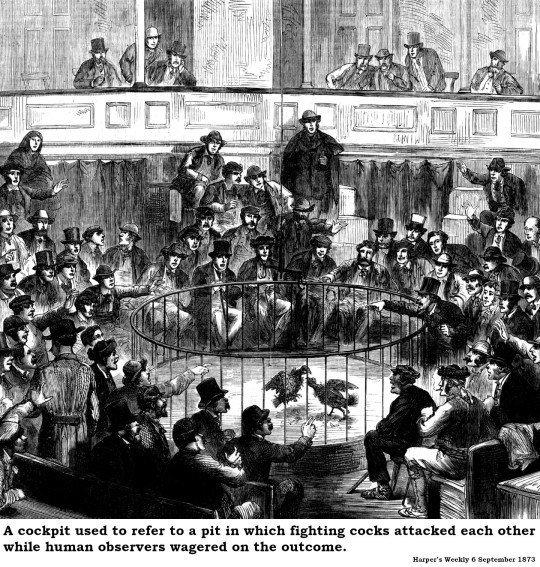
Combination
Strictly speaking, in the 1800s, a “circus” was that entertainment taking place withing a sawdust “ring” which in Latin was “circus.” The other aspects of the modern circus – the traveling zoo known as the “menagerie” and the “side-show” or “exposition” – were considered separate enterprises. The first impresarios to “combine” all of these shows called them “combinations.” So, we have the Cincinnati Gazette [8 June 1872] reporting: “Warner’s big combination show attracted an immense crowd of spectators yesterday afternoon and evening.” And old John Robinson advertised his traveling spectacular as “Robinson’s Great Combination.”
Dashboard
We use “dashboard” today to talk about status displays on our computer screens, which derived from the instrument panel in our automobiles, which referred to the array of gauges and dials in an aeroplane. But there was a much earlier and practical use of this word as the actual wooden board at the front of a carriage that kept stones and mud from being kicked into the driver’s face. From the Cincinnati Dollar Weekly Times [1 November 1855]: “The mare was put between the thills of a nice light buggy, her harness thoroughly adjusted by the owner, the reins carefully laid over the dashboard, and the usual chapter of advice opened concerning her management.”
Drummer
An old definition of this word, metaphoric in origin, has nothing to do with music. A drummer was a salesperson, usually a traveling salesman, and usually a man on commission. The Enquirer [22 December 1871] reported: “The State of Maryland has in force a statute similar to that of Tennessee and several other States, which classes ‘drummers’ selling goods by sample for houses out of the State with peddlers, and exacts a license from them so heavy as to prohibit effectually sales in those States.”
Embarrassed
If you realize, after ordering at an expensive restaurant, that you left your wallet at home, you might be embarrassed. That is close to the old-time definition of this word. It meant bankrupt. The Cincinnati Gazette [27 April 1837] related the story of a scoundrel named John Law: “With him perished all Law’s hopes for regaining his personal fortune. He became embarrassed; suits were commenced against him.”
Grocery
So many old-time groceries offered liquor by the glass that “grocery” came to mean almost any saloon that emphasized the hard stuff over beer. Here’s the Western Christian Advocate [20 May 1836]: “When I hear a man say ‘my cigars cost me two dollars a week’ – I should not be surprised if I see him drinking in a grocery or tavern.”
Hilarious
The history of comedy reminds us that we find drunks to be humorous. Back in the day, “hilarious” did not mean funny; it meant extremely inebriated. The Enquirer [14 January 1870] recounted one such case: “Night before last, this identical phonographer, who now calls himself Henry Henderson, was found in a highly hilarious condition, enjoying the society of ugly females in a bad house on Eighth street.”
Map
There are abundant synonyms for physiognomy, but Cincinnati in the 1890s had a good one – “map.” In regaling his readers with memories of post-midnight culinary delights, Frank Grayson recalled Simon the Hot-Corn Man, who slathered his steaming ears of corn with “a substance that passed as butter.” Grayson recollected how “There were a lot of greasy maps decorating Vine Street in the wake of Simon.”
Queer
In recent times, “queer” has settled into a linguistic niche as a sobriquet for what used to be called “alternative lifestyles.” Around 1880, however, the primary connotation of “queer” was financial. It referred to counterfeit money. The Cincinnati Gazette [28 October 1873] reported on the trial of M.Y. Morton: “He is an old gray haired man, and told the detective that he had been ‘pushing the queer’ for thirty-five years, making a good business in buying and selling counterfeit.”
Slut
Ever since it became a term of sexist opprobrium, “bitch” has been ruined as the technical name for a female canine. Few today remember that “slut” was synonymous with “bitch” and also referred to distaff dogs. An advertisement in the Cincinnati Commercial Tribune [21 June 1870] sought: “Dogs – Two full blood Scotch rat terriers dog and slut. Must be a year old or older.”
Snide
You rarely hear this word today outside the phrase “snide remark.” When you do, it often has the tint of sarcasm. In old Cincinnati, however, “snide” meant fake, cheap or counterfeit. The Cincinnati Daily Star [23 January 1880] recorded that “Ed. Kline was pulled in yesterday for selling ‘snide’ jewelry.” The term applied to people, too. The Enquirer [5 April 1880] noted: “A snide party styling themselves Tennessee Minstrels were rotten-egged and mobbed in Easton, Maryland, on Friday night.”

11 notes
·
View notes
Text
Digital Marketing Agency vs. Traditional Advertising: The New Era
In the ever-evolving landscape of business promotion and brand visibility, the tug-of-war between traditional advertising and digital marketing is a topic of keen interest. As the world embraces digital transformation, "The Unplugged Web," a leading digital marketing agency, emerges as a guiding light for businesses seeking to navigate this new era and make strategic choices that yield remarkable results.
The Digital Shift: A Paradigm Transformation
Traditional advertising, once the cornerstone of brand promotion, now shares the stage with its digital counterpart. The rise of the internet and the proliferation of online platforms have fundamentally changed the way businesses interact with their audience. This shift calls for a fresh perspective, and "The Unplugged Web" steps into this arena with a dynamic approach that marries technology and creativity.
Traditional Advertising: The Old Guard
Print ads, TV commercials, and billboards were once the kings of advertising. While these methods have their merits, their reach is often limited, and measuring their impact can be challenging. "The Unplugged Web" recognizes the value of traditional methods but also understands their limitations in the digital age.
Enter Digital Marketing: A Dynamic Frontier
Digital marketing encompasses a broad spectrum of strategies, from search engine optimization (SEO) and Pay-Per-Click (PPC) advertising to social media marketing and Online Reputation Management (ORM). "The Unplugged Web" operates as a multifaceted digital marketing company, offering a range of services that tap into the potential of the digital landscape.
Precision Targeting: The Essence of Digital
Unlike traditional methods, digital marketing allows for precision targeting. With "The Unplugged Web" as your partner, you can reach your exact target audience, whether they're in Albuquerque, New Jersey, Akron, Myrtle Beach, Charleston, Cincinnati, Detroit, or Cleveland. This level of specificity enhances the likelihood of engagement and conversion.
Data-Driven Insights: A Strategic Advantage
One of the most compelling aspects of digital marketing is the wealth of data it generates. "The Unplugged Web" harnesses these insights to refine strategies and optimize campaigns in real time. This data-driven approach ensures that your marketing efforts are continually evolving to meet the ever-changing demands of your audience.
Synergy of Services: The Unplugged Web Advantage
"The Unplugged Web" isn't confined to a singular approach. They're not just a search engine optimization company or a social media marketing services provider; they're a comprehensive digital marketing agency that combines various strategies for a cohesive and impactful brand presence.
Choosing Your Path: The Road to Success
In the face of this dichotomy, the question arises: traditional advertising or digital marketing? The answer lies in a strategic blend that caters to your business's unique needs and goals. "The Unplugged Web" collaborates with you to understand your objectives and crafts a tailored approach that leverages the strengths of both worlds.
Embrace the New Era with The Unplugged Web
As the digital era continues to redefine how businesses connect with their audience, "The Unplugged Web" stands as a beacon of innovation and expertise. Their holistic approach, encompassing search engine optimization, PPC advertising, best social media marketing services, and more, positions them as the partner of choice for businesses aiming to thrive in the new age of advertising.
In a world where the digital and traditional collide, "The Unplugged Web" is your guide to navigating the shifting tides of advertising, ensuring that your brand sails smoothly into the future of marketing success.
0 notes
Text

Phoenix Design Works is a branding, marketing and advertising creative firm with extensive experience in the educational, collegiate, consumer and pro sports marketplaces. Our leading business focus encompasses the following three areas:
I. Branding and Logo Identity Programs
II. Advertising and Promotional Campaigns
III. Packaging and New Product Development
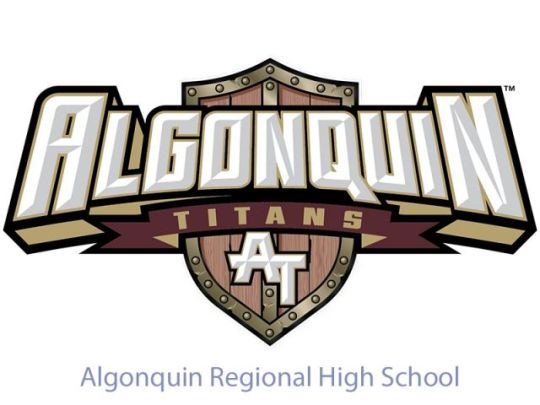
Phoenix Design Works has created and developed some of the best loved and most memorable collegiate brands in the world today. Phoenix has created the branding, advertising and/or Look of the Game programs for College Football Bowl Games such as The Boca Raton Bowl, The Camellia Bowl, The Chick-fil-A Peach Bowl, The St. Petersburg Bowl and the The Valero Alamo Bowl and college sports properties such as Michigan's The Big Chill, the world's largest outdoor hockey event. We have also created branding and advertising programs for hundreds of collegiate clients across America, both athletic and institutional. Phoenix collegiate clients include Adelphi, Alabama, Arkansas, Binghamton, Brown, Colgate, Delaware State, Drake, Hampton, Harvard, Illinois, LSU, Marist, Moorpark, NC A&T, OU, Roanoke, Saint Joseph's, Siena, Tennessee, Troy, UCLA, UC Merced, UCSB, UMass and UTRGV. Phoenix has also branded dozens of collegiate conferences including the Atlantic Sun, Atlantic 10, Big West, ECC, the ECAC, the LEC, the MAAC, MVC, OVC and SOCON.
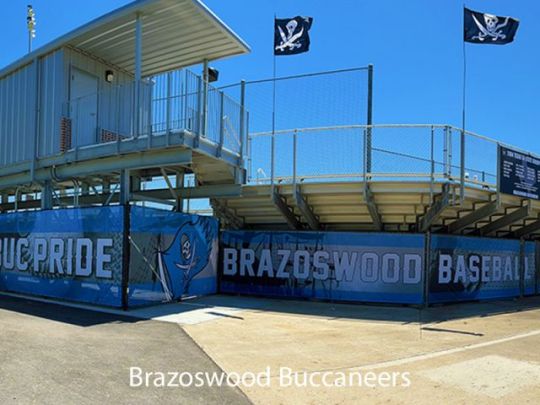
We have created franchise identity, property development and event branding for all major league sports including all visual identity, logo marks and uniform design for the Colorado Rockies, Cincinnati Reds, Florida Marlins, Philadelphia 76'ers, Seattle Sonics, Toronto Blue Jays, and Vancouver Grizzlies. Event branding includes properties such as Opening Day, the World Series, the All-Star Game, the US Open and the Super Bowl. Phoenix has created the branding and promotion for the Northwest Arkansas Naturals and the Buffalo Bisons. Phoenix has also created the principle branding for the USTA, Major League Soccer, NASCAR, the Indy 500, the US Grand Prix, the Breeders' Cup, the NTRA, the WPVA, and WUSA. In sports broadcast Phoenix has created on air broadcast properties branding, consumer promotion, event branding and promotion, and packaging for ESPN, Fox, DirecTV, and G4.
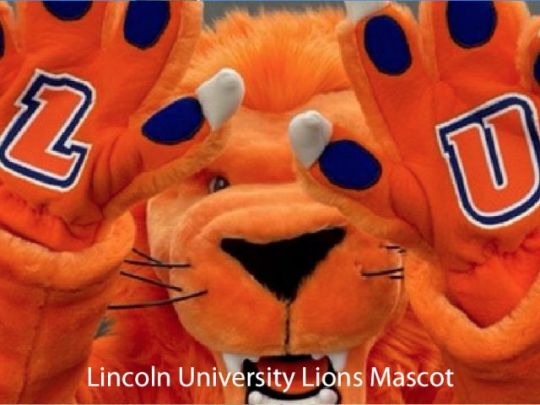
Phoenix has created comprehensive branding and advertising programs for over 50 of the Fortune 500 consumer brands. Our experience in corporate and consumer branding ranges from the world's largest manufacturers to the world's most famous entertainment companies. For Walt Disney Companies, Phoenix has produced consumer branding, web design, film property development and consumer retail store branding. Phoenix Design Works has conducted both national and international brand launch initiatives for Coca-Cola Companies, Diageo Brands Worldwide, Guiness Brewing, Kraft General Foods and Reebok. PDW has created new category product launches for Coca-Cola and Guiness, and produced a comprehensive cross category audit and redesign of the entire Maxwell House Coffees product line. Our consumer product development experience includes new product design for Diageo Brands, Durex, Mucinex, SKYY Vodka, and Swatch Watches, as well as a complete brand audit and consumer packaging design and development for DIRECTV and Fox Interactive Video Games.

Phoenix created and launched new national advertising and promotional initiatives for Fireball Cinnamon Whisky and Don Julio Tequila inclusive of all national print and outdoor media. Phoenix consumer branding clients also include Accenture, Amblin, American Express, Apple, Burger King, Ford, Jaguar Motor Cars, John Deere and MasterCard. Phoenix Design Works has also worked as brand forecasters as well as brand agency of record for Bill Gates global photo agency Corbis, and Corbis Green Light. Phoenix Design Works has also created multiple brand campaigns for HP, Specifically their global esports platform, Omen.
At Phoenix Design Works we distinguish ourselves from our competitors by the depth and breadth of our work experience. We combine our experience across collegiate, pro sports & entertainment and consumer branding and bring that experience to play on behalf of every client that we work with. When you hire Phoenix Design Works, you are hiring a company with a proven track record for getting results and producing branding that generates revenue and withstands the test of time. The experience we leverage on behalf of our clients serves to enhance the branding assets that will become your new program and ready it for launch. Whether it's the research process, the creative process, or the client service we deliver throughout the course of the project, it is our past experience that raises the bar on the process overall, and makes for a superior result and experience for our clients.
Phoenix Design Works has been hired to create new or refreshed logo programs, develop advertising and marketing campaigns and to create facilities branding programs for team and institutions. "Our strength is in combining sound strategic thinking with solutions that best serve our client's needs, resonate with their constituents and increase their revenue".
Branding is the way you are perceived by your audience, whether they be prospective admissions for your constituent members, conference partners, current student athletes, parents, donors, or the community at large. Communications media is the means by which you deliver your message to this audience, be it via legacy media such as newspapers and direct mail or digital media platforms such as websites, social media and email.
At Phoenix Design Works we make sure that your new brand will deliver across all these different platforms. As our Principle and Creative Director James M. Skiles says, "A brand never gets a second chance to make a first impression". At PDW we make sure a consumer's first impression builds a lifetime of brand engagement.
Phoenix Design Works has earned national & global recognition and prominence in the areas of branding, design and advertising, with awards and press coverage from American Corporate Identity, Case Awards, Graphis, How, NACDA, P.I.E., Japan and Print Magazine. Our collegiate clients have also been awarded NACDA/NACMA marketing awards.
#wind screens#visual branding#school branding#print advertising#Logo Design#logo#facilities branding#Digital Advertising#branding#Banners#athletic branding#advertising campaign#Advertising#windscreens#visualbranding#schoolbranding#printadvertising#logodesign#Logo#facilitiesbranding#digitaladvertising#banners#athleticbranding#advertisingcampaign#advertising
1 note
·
View note
Text
Website Design in Cincinnati, OH
Website design in Cincinnati, OH has never been more accessible than with DMN8 Partners. As a premier digital marketing agency, DMN8 Partners specializes in creating custom websites that cater to the specific needs of businesses. Their expert team of professionals work closely with home service business owners to craft visually appealing, highly functional, and optimized websites that rank well in search engine results pages (SERPs).
DMN8 Partners uses the latest web design technologies to create responsive websites that look great on any device, including smartphones and tablets. The agency's website design services include optimized page load times, clear calls-to-action, and a user-friendly interface that is easy to navigate. DMN8 Partners also provides ongoing website maintenance and support to ensure that the client's website remains up-to-date and performs at peak efficiency.
The agency's expertise in website design and development ensures that clients receive a custom solution that meets their unique needs and helps them achieve their business goals. DMN8 Partners understands that a well-designed website is essential for any business, especially in the highly competitive world of home services.
Their website design services are designed to help businesses establish a strong online presence, attract more traffic to their site, and generate more leads and sales.
In addition to website design, DMN8 Partners also offers a range of other digital marketing services, including search engine optimization (SEO), pay-per-click (PPC) advertising, social media management, and content creation. These services work together to create a comprehensive digital marketing strategy that helps businesses maximize their online potential.
Overall, DMN8 Partners is the go-to agency for home service business owners in Cincinnati, OH who want to improve their online presence with a visually appealing, highly functional, and optimized website. With their expertise in website design and development, coupled with their other digital marketing services, DMN8 Partners can help businesses establish a strong online presence and grow their businesses.
DMN8 Partners
50 E Rivercenter Blvd Suite 600
Covington, KY 41011
+18597572252
https://www.facebook.com/search/top?q=dmn8%20partners
https://www.linkedin.com/company/dmn8-partners/
1 note
·
View note